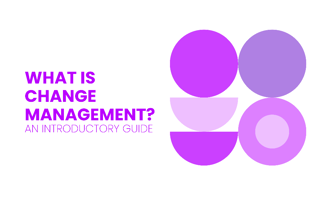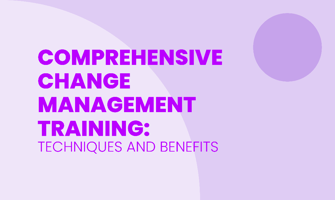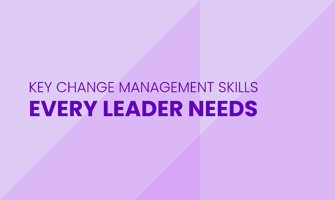Change management is the systematic approach to transitioning or transforming an organization's...
Top Change Management Models Explained: Kotter, Lewin, and More
Change management helps organizations handle the complexities of transformation. It involves guiding employees through transitions using various models and theories. These models provide a clear plan to manage change, ensuring smooth and effective transitions. They reduce risks and increase the chances of success.
Whether responding to market changes or internal restructuring, change management models are invaluable. This article explores the most important models of change management, explaining their importance and offering practical insights into how they can be implemented in your organization.
To find out more about change management, head to What is Change Management? An Introductory Guide
Importance of Top Change Management Models
Change management is the process of guiding an organization through transitions to achieve desired future states. Change management models provide clear steps to manage these transitions effectively. They help you plan, implement, and support changes within your company.
A good change management strategy ensures that everyone in your organization accepts and supports the change. Employees are crucial to making change successful. Having a dedicated change management team allows you to better anticipate resistance, plan for it, and create a supportive environment. Companies with dedicated change management teams see a 52% increase in successful transformations, underscoring the importance of a structured approach.
Effective change management improves communication, boosts employee engagement, and creates a more adaptable culture. Using these models helps you implement new systems and processes efficiently, giving your organization a competitive edge in a fast-changing business world.
![]()
Top Change Management Models
1. Kotter's 8-Step Change Model
Kotter's 8-Step Change Model is a clear method for making changes in an organization. It was created by Harvard Professor Dr. John P. Kotter. The model has eight steps that help guide the change process smoothly and effectively.
Create a sense of urgency: Make everyone aware of the need for change to motivate them to act.
Build a guiding coalition: Form a strong team to lead and support the change.
Form a strategic vision and initiatives: Set clear goals and plans for the change.
Enlist a volunteer army: Get more people involved and excited about the change.
Enable action by removing barriers: Identify and remove obstacles that could slow down or stop the change.
Generate short-term wins: Achieve small, quick successes to build momentum.
Sustain acceleration: Keep pushing forward to continue the progress.
Institute change: Make the changes a permanent part of the organization's culture.
Importance
Emphasizes the human side of change management: Recognizes that people's attitudes and behaviors are key to successful change.
Creates a sense of urgency: Helps overcome complacency by making everyone aware of the need for change.
Provides a step-by-step approach: Offers a clear path to embed change deeply within an organization's culture.
Advocates for a clear vision and effective communication: Ensures everyone understands the goals and is motivated to act.
Highlights the importance of quick wins: Securing early successes builds momentum and encourages continued effort.
Techniques to Implement Kotter's 8-Step Change Model
Conduct workshops and training sessions: Communicate the urgency and vision to all employees, ensuring everyone understands and supports the change. Tools like interactive presentations and collaborative platforms can enhance engagement.
Utilize project management tools: Use tools such as Gantt charts, which are timeline-based project schedules, Kanban boards, which are visual task management boards, and project tracking software to organize the progress of initiatives and identify any barriers that need to be addressed.
Celebrate short-term objectives: Recognize achievements through recognition programs, awards, or company-wide announcements to build momentum. Digital communication tools and internal social networks can help spread the news.
Reinforce new ways of working: Use regular feedback loops and strategies like nudge theory to encourage and maintain new behaviors and practices. Nudge theory involves small prompts or suggestions to influence behavior positively and subtly. Techniques like surveys, feedback apps, and continuous improvement software can support these efforts. Tools like 180ops integrate CRM, customer service, and sales data to provide real-time insights, empowering your team to implement these models more effectively and drive exceptional revenue growth.
![]()
2. Lewin's Change Management Model
Kurt Lewin's Change Management Model, developed by the renowned social psychologist, provides a clear and structured approach to understanding and implementing organizational change. This model divides the change process into three distinct phases:
Unfreeze: In this phase, the organization prepares to accept that change is necessary. This involves breaking down the existing status quo, challenging current beliefs, and creating awareness of the need for change. It sets the stage for transformation by making people understand why change is essential.
Change: During this phase, the organization begins to transition towards a new way of functioning. This involves implementing new processes, behaviors, or attitudes. The focus is on developing new ways of working and ensuring that everyone adapts to these changes. Communication, support, and education are crucial during this phase to help people move from uncertainty to acceptance.
Refreeze: The final phase involves stabilizing the organization in its new state. This is where the changes are solidified and integrated into the organizational culture. It ensures that the new ways of working are maintained over time and become the standard practice. Reinforcement, continuous support, and monitoring are essential to prevent regression to old habits.
Importance
Emphasizes preparation: Ensures the organization is ready for change, reducing resistance and anxiety among employees.
Provides a clear roadmap: Guides organizations through the steps of change, from preparation to stabilizing the new way of working.
Addresses resistance: By breaking the change process into phases, it helps reduce resistance and ensures smoother transitions.
Ensures lasting change: The final phase focuses on making the new changes permanent, and integrating them into the organization's culture.
Techniques to Implement Lewin's Change Management Model
Conducting a thorough analysis of stakeholders: Measure resistance and readiness for the change using surveys, feedback tools, and stakeholder mapping techniques. This helps you understand how different groups will react and prepares strategies to manage these reactions.
Developing a plan with clearly defined milestones and objectives: Use project management tools like timelines and task lists to guide the change process. This provides a clear path to follow and helps track progress.
Appointing and training 'change champions': Select and train individuals using training workshops and peer support programs. Change champions influence others by demonstrating new behaviors and supporting their colleagues throughout the transition.
Ensuring the longevity of the change: Embed continuous training opportunities and performance incentives using online learning platforms and rewards systems. This helps solidify the changes and make them a permanent part of your organization's culture. Continuous training keeps everyone updated on new practices, while incentives encourage maintaining these practices.
![]()
3. ADKAR Model
The ADKAR Model structures change around five key goals that an individual must achieve for change to be successful. These goals are:
Awareness: Understanding the need for change.
Desire: Wanting to participate in and support the change.
Knowledge: Knowing how to change.
Ability: Demonstrating the skills and behaviors needed for change.
Reinforcement: Ensuring the change is maintained over time.
This model highlights that successful organizational change is the result of individual transitions. Each person must achieve these goals for the overall change to be effective.
Importance
Pinpoint personal barriers: Identify and address individual obstacles during a change initiative.
Provide solutions: Offer targeted solutions to help individuals overcome these barriers.
Follow a clear sequence: Use a step-by-step approach that is easy to follow and implement.
Adapt to any scale: Apply the model to both small and large-scale changes.
Align individual and organizational change: Ensure that personal transitions support and align with broader organizational shifts.
Techniques to Incorporate the ADKAR Model
Host informative sessions: Build awareness and desire for change by being clear about the expected transition. Use interactive webinars and virtual meetings to provide information and engage employees.
Offer comprehensive training programs: Improve your employees' skills and knowledge to support the change. Provide hands-on workshops, simulations, and role-playing exercises to help employees practice new skills in a controlled environment. Use learning management systems to track progress and deliver consistent training.
Provide mentorship and coaching: Help your employees develop through the change process. Set up peer mentoring systems and coaching sessions to support new skills and behaviors. Regular check-ins and feedback sessions can further enhance personal development.
Develop a reward system: Reinforce new behaviors by making them a company norm. Use performance tracking tools to monitor progress and offer recognition programs and incentives to encourage and maintain the changes.
4. McKinsey 7-S Model
The McKinsey 7-S Model is a comprehensive tool used to diagnose and improve organizational effectiveness. It categorizes seven interdependent factors that are crucial for success:
Strategy: The plan to achieve long-term goals.
Structure: How the organization is arranged, including roles and responsibilities.
Systems: The processes and procedures that guide daily operations.
Shared Values: The core beliefs and cultural elements that bind the organization.
Style: The leadership approach and organizational culture.
Staff: The people and their capabilities within the organization.
Skills: The specific competencies and capabilities of the organization.
This model not only looks at each factor individually but also emphasizes the importance of aligning and integrating these elements when planning and implementing change.
Importance
Views the organization as a complex system: Recognizes that different parts of the organization are interconnected and must work together.
Lays the groundwork for strategic change: Provides a framework for making comprehensive changes that align with the organization's long-term goals.
Ensures alignment and synergy: Helps align diverse aspects of the organization, ensuring they support each other and work towards common objectives.
Addresses both hard and soft elements: Balances structural aspects (strategy, structure, systems) with cultural and people-focused elements (shared values, style, staff, skills), ensuring a holistic approach to change.
Techniques to Utilize the McKinsey 7-S Model
Perform a detailed analysis: Compare your current organizational state with the desired future state to identify areas that need change. Use gap analysis tools, which help identify the differences between current and desired performance, and SWOT analysis, which assesses strengths, weaknesses, opportunities, and threats, to highlight differences and areas for improvement. This helps you understand what needs to change and where to focus your efforts.
Cultivate an integrated approach: Ensure that none of the seven elements operates in isolation. Use strategy alignment workshops and cross-departmental meetings to align strategy, structure, systems, shared values, style, staff, and skills. This promotes organization-wide changes that are cohesive and well-coordinated.
Foster cross-functional dynamics: Encourage communication and collaboration across different departments. Implement team-building activities, cross-functional projects, and collaborative platforms to enhance interaction and teamwork. Regular inter-departmental meetings can also help in sharing insights and solving problems collectively.
Integrate regular monitoring: Conduct feedback sessions and continuous assessments to optimize the strategy. Use performance tracking tools, regular reviews, and feedback loops to ensure adherence to the change trajectory and make necessary adjustments. Regular surveys and evaluation tools can help you track progress and identify areas that need further attention.
When to Choose Which Model
1. Scope and Scale of Change
Kotter's 8-Step Change Model: Choose this for large, organization-wide changes that need a detailed and structured approach.
Lewin's Change Management Model: Best for smaller, more focused changes that can be managed with a simple, three-step process.
2. Organizational Culture
Kotter's 8-Step Change Model: Works well in organizations with strong leadership and a top-down approach.
ADKAR Model: Best for organizations that value personal growth and employee involvement.
3. Time Frame
Kotter's 8-Step Change Model: Effective for changes that need to be implemented over a long period, typically more than one year.
Lewin's Change Management Model: Ideal for quick changes that can be done in a few months.
4. Complexity of Change
McKinsey 7-S Model: Suitable for complex changes that need to align many different parts of the organization.
ADKAR Model: Ideal for changes that focus on individual employee behavior and skills, ensuring that each person can adapt effectively.
![]()
Conclusion
Change management models are essential tools for guiding organizations through the complexities of transformation. They provide structured approaches to manage change effectively, ensuring that the process is smooth and successful.
Using these models gives you a clear plan for handling change, helping your organization become strong and flexible. Embracing change can drive growth and innovation, making your organization more resilient and adaptable.
FAQs
What is the importance of a change management framework in organizational change management?
A change management framework is crucial for guiding organizational change management. It ensures that change initiatives are implemented smoothly, helping manage the phasen of change for greater erfolg.
How does change management theory impact the implementation of change initiatives?
Change management theory, such as the Kubler-Ross change curve, provides a structured approach to implementation. This helps align change initiatives with organizational goals, leading to a greater, growth process, erfolg, and smoother phasen.
What are some employee experience trends in the context of change management theory?
Employee experience trends highlight the need for effective change management theory to address the human side of transitions. Implementing a change management framework improves engagement, and business strategy, ensuring successful change initiatives and transformational periods.
How does the PDSA cycle contribute to the success of change initiatives?
The PDSA cycle supports the implementation of change initiatives by providing a systematic approach. This framework ensures effective testing and refining of changes, improving overall erfolg and handling the phasen of change.
How does Bridges’ Transition Model assist in managing change requirements?
Bridges Transition Model helps manage change requirements by focusing on psychological transitions. This framework ensures that change initiatives align with employee needs, and business processes, leading to greater erfolg and smoother phasen.




